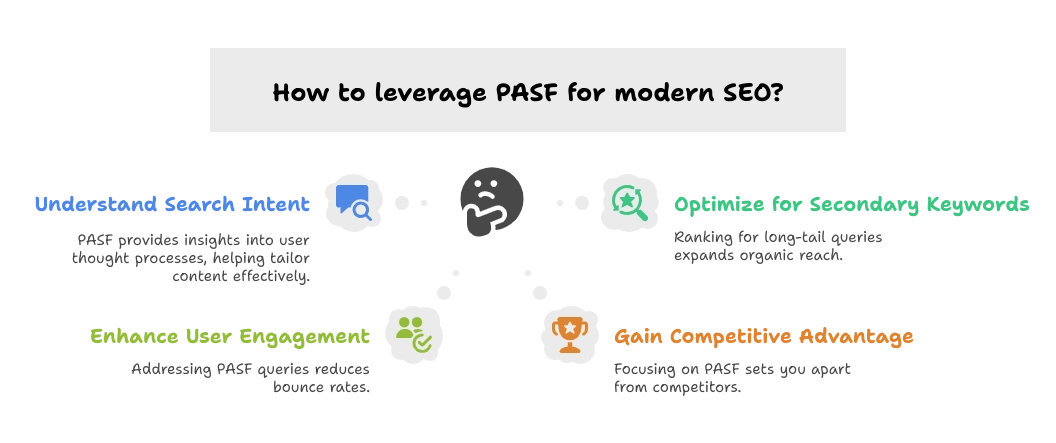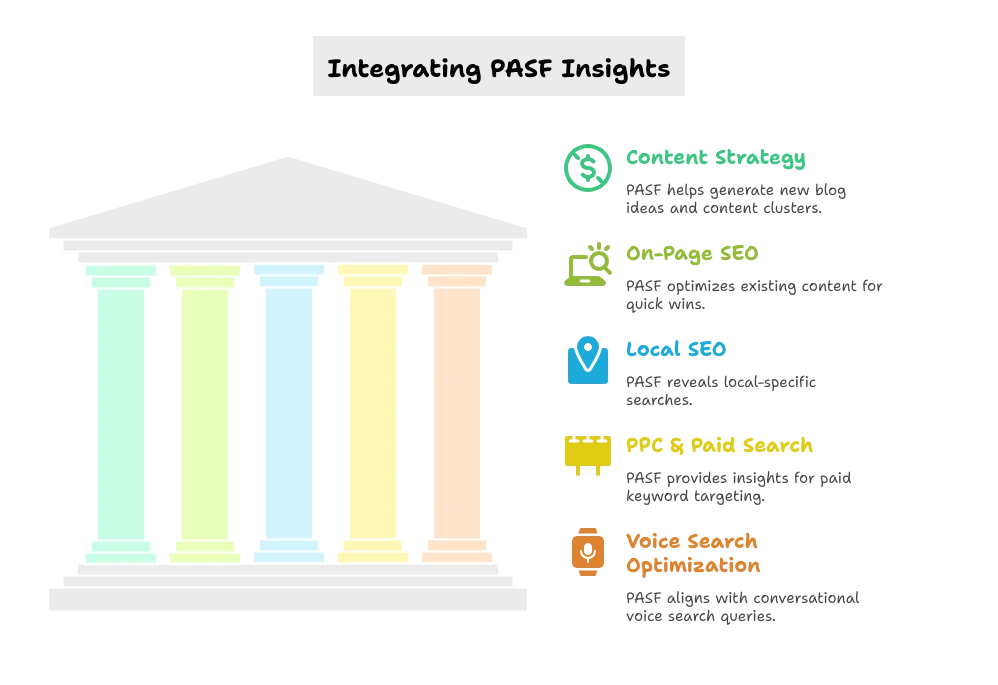Objective
The objective of this blog is to explain what People Also Search For (PASF) means, why it matters in SEO, and how businesses can use it to improve keyword research, content optimization, and overall search visibility.
When you search on Google, you often notice a small section appearing under some results with the label “People Also Search For” (PASF). This feature suggests related queries that users typically search after typing in their original keyword.
For example, if someone searches for “best SEO tools” and clicks on a result but quickly returns to the search page, Google may show them PASF suggestions like “free SEO tools,” “SEO software for beginners,” or “keyword research tools.”
Did you know? Over 92% of all keywords show related searches like PASF, proving that Google heavily relies on this feature to guide users toward refining their queries.
The goal is to help users refine their search and find more relevant answers. From Google’s perspective, PASF is a user-experience feature. From an SEO perspective, however, it opens up a world of opportunities.
PASF reflects real search behavior and reveals what people are interested in alongside the original keyword. For businesses and content creators, it’s essentially Google handing over related keyword ideas that can expand visibility and capture additional traffic.
Key Takeaways
- PASF reveals real user intent and provides valuable related keyword ideas straight from Google.
- Optimizing content with PASF queries helps capture more long-tail traffic and improve visibility.
- PASF-driven content reduces bounce rates by answering user follow-up questions effectively.
- Integrating PASF into your SEO strategy builds topical authority and creates a competitive advantage.
Table Of Contents
- Why PASF Matters in Modern SEO
- The Impact of PASF on User Search Intent & Click Behavior
- Leveraging PASF for Smarter Keyword Research
- Content Optimization Techniques for PASF Visibility
- Measuring PASF Performance with SEO Tools & Analytics
- Integrating PASF Insights into Overall SEO Strategy
- Common Obstacles in PASF Optimization & How to Overcome Them
- Making PASF Work for Your SEO Success
- FAQs About People Also Search For
Why PASF Matters in Modern SEO
SEO today is no longer about stuffing a page with one keyword. Instead, it’s about understanding search intent and creating content that answers multiple user questions.

Here’s why PASF matters:
- Insight into Search Intent: PASF shows the natural progression of a user’s thought process. If your audience searches for “local SEO services,” they might also be interested in “affordable SEO packages” or “SEO agency near me.”
- Opportunities for Secondary Keywords: By optimizing for PASF queries, your content can rank for long-tail and related terms, expanding your organic footprint.
- Better User Engagement: If your content directly addresses PASF queries, visitors are less likely to bounce back to Google. They find what they need on your page itself.
- Competitive Advantage: Many websites still focus only on primary keywords. Leveraging PASF can give you an edge over competitors.
In short, PASF isn’t just a side feature of Google—it’s a strategic tool for modern SEO.
The Impact of PASF on User Search Intent & Click Behavior
The PASF feature doesn’t just suggest keywords—it actively influences how people continue their search journey.
- Extending Search Paths: Instead of stopping at one query, users often follow PASF prompts to explore related questions. This leads to more page visits and deeper research.
- Shaping Content Discovery: PASF can bring your content into the spotlight, even if the user didn’t initially search for your exact topic.
- Lowering Bounce Rate Through Relevance: If you target PASF queries in your content, you answer what users are likely to ask next—keeping them on your site longer.
Example:
A user searches “how to rank higher on Google.” The PASF might show “SEO strategies for small businesses” or “on-page SEO checklist.” If your blog covers these too, the visitor finds everything in one place instead of leaving.
Thus, PASF plays a dual role—helping users refine their intent and helping websites capture wider traffic.
Leveraging PASF for Smarter Keyword Research
PASF is a goldmine for keyword research. Instead of only relying on tools, you get keyword suggestions directly from Google based on actual user behavior..
Here’s how to use PASF effectively:
- Start with a Seed Keyword: Search your main keyword (e.g., “digital marketing agency”) and note the PASF queries that appear.
- Analyze Patterns: Look for recurring phrases or themes across PASF results. These often reveal user intent clusters.
- Expand Content Topics: Each PASF keyword can be turned into a sub-heading, FAQ, or even a standalone blog post.
- Combine with Other Sources: Use PASF alongside “People Also Ask” (PAA), Google Autocomplete, and tools like SEMrush or Ahrefs for a full keyword map.
For example, searching “Ecommerce SEO” may show PASF suggestions like “best ecommerce SEO tools” or “ecommerce SEO checklist.” Both are perfect for additional blog sections.
By collecting PASF data systematically, you can build a content strategy based on real search behavior, not just guesswork.
Content Optimization Techniques for PASF Visibility
Once you know which PASF keywords are relevant, the next step is optimizing your content.
Techniques to Appear in PASF:
- Use PASF Keywords Naturally: Integrate them into your headings, subheadings, and body text without keyword stuffing.
- Create Comprehensive Content: Cover the main keyword plus all related PASF queries in one article. This increases the chance of your page showing up when users refine their search.
- Optimize for Questions: Many PASF suggestions are phrased as questions. Answer them clearly and concisely in your content.
- Leverage Internal Linking: If you can’t cover all PASF queries on one page, create multiple pages and interlink them.
- Enhance User Experience: Structured formatting (bullet points, FAQs, short paragraphs) makes your content more PASF-friendly.
- Schema Markup: Adding FAQ schema or Q&A markup can improve chances of being featured in PASF-related snippets.
Example: A blog titled “Local SEO Guide” can include PASF-driven sections like “Why local SEO is important,” “How to optimize Google My Business,” etc.
Measuring PASF Performance with SEO Tools & Analytics
Tracking PASF performance is critical to know whether your efforts are paying off.
Tools You Can Use:
- Google Search Console (GSC): Track impressions, clicks, and queries where PASF keywords appear.
- Ahrefs / SEMrush: Monitor ranking positions for PASF-related keywords.
- Google Analytics: See how visitors interact with your content after landing from PASF queries.
- SEO Minion / Chrome Extensions: Quick tools to extract PASF keywords directly from search results.
Metrics to Focus On:
- Growth in traffic from related long-tail keywords
- Lower bounce rates due to better content relevance
- Improved ranking positions for PASF queries
- Increase in average session duration
Measuring these KPIs ensures you’re not just adding PASF keywords blindly—you’re tracking their real impact on SEO performance.
Integrating PASF Insights into Overall SEO Strategy

PASF should not be treated as a stand-alone tactic. Instead, it should be woven into your broader SEO plan.
- Content Strategy: Use PASF to generate new blog ideas, FAQs, and content clusters.
- On-Page SEO: Optimize existing content with PASF queries for quick wins.
- Local SEO: PASF often reveals local-specific searches. For example, “best dentist near me” may lead to related PASF like “affordable dental services.”
- PPC & Paid Search: PASF can provide insights for paid keyword targeting as well.
- Voice Search Optimization: Many PASF queries are conversational, aligning well with voice search.
By integrating PASF into keyword planning, on-page SEO, content creation, and even paid ads strategies, you ensure your site addresses all layers of search intent.
Common Obstacles in PASF Optimization & How to Overcome Them
Like any SEO tactic, PASF optimization comes with challenges.
Challenges
- Constantly Changing PASF Results: Google updates PASF suggestions dynamically, making it difficult to rely on static lists.
- High Competition: Popular PASF queries often attract multiple websites targeting the same terms.
- Limited Data from Tools: Unlike regular keywords, PASF insights are not always available in SEO tools.
- Content Overlap: Covering too many PASF queries in one place can make content redundant.
Solutions
- Update Content Regularly: Keep refreshing your blog posts to match new PASF trends.
- Target Long-tail Variations: Go after less competitive PASF queries for quicker rankings.
- Use Manual Research: Combine tool-based data with live Google searches to stay accurate.
- Content Structuring: Group PASF queries into logical clusters to avoid duplication.
Overcoming these challenges ensures PASF becomes a long-term SEO asset instead of a short-lived tactic.
Making PASF Work for Your SEO Success
“People Also Search For” is more than just a small box on Google—it’s a roadmap to user intent.
By understanding PASF and optimizing your content around it, you can:
- Capture more organic traffic
- Improve user engagement
- Enhance topical authority
- Gain an edge over competitors
The key is to treat PASF as part of a holistic SEO strategy. Use it for keyword research, content planning, user intent mapping, and even paid campaigns. Monitor performance, adapt to changes, and keep refining your approach.
In today’s competitive SEO landscape, ignoring PASF means leaving potential traffic on the table. By mastering it, you not only rank higher but also create content that truly satisfies what people are searching for—both now and next.
- Constantly Changing PASF Results: Google updates PASF suggestions dynamically, making it difficult to rely on static lists.
- High Competition: Popular PASF queries often attract multiple websites targeting the same terms.
- Limited Data from Tools: Unlike regular keywords, PASF insights are not always available in SEO tools.
- Content Overlap: Covering too many PASF queries in one place can make content redundant.
Want to Reduce Bounce Rates and Keep Visitors Longer?
Answer PASF queries in your content to engage users, provide complete answers, and improve overall site performance.
FAQs About People Also Search For
“People Also Search For” (PASF) is a Google search feature that suggests related keywords or queries users often look for after searching their original term. It usually appears when someone clicks a search result and then quickly returns to the results page, signaling that they may need more relevant information.
PASF appears after a user clicks a result and returns, suggesting related queries. PAA shows interactive questions directly on the search page. Both highlight user intent but function differently, offering unique opportunities for keyword research and SEO optimization.
PASF reveals related search terms users explore after the main query. These suggestions uncover long-tail keywords, highlight real user intent, and provide insights for creating content that covers broader topics, ultimately improving organic visibility and search rankings.
Google displays PASF when it detects the clicked result didn’t fully satisfy the query. By offering related searches, it refines intent, helping users find more relevant information while giving marketers deeper keyword opportunities.
Yes. By optimizing content around PASF keywords, you can capture additional long-tail traffic, expand topical coverage, reduce bounce rates, and rank for multiple variations of a query. This strengthens your site’s authority and overall organic search performance.
Tools like SEMrush, Ahrefs, Ubersuggest, and SEO Minion can extract PASF keywords. Marketers also collect them manually from Google searches. These tools streamline research, uncover keyword variations, and guide content strategies for better SEO outcomes.
No. PASF suggestions can differ across devices due to search behavior, location, and screen experience. Mobile users may see slightly different PASF queries than desktop users, reflecting Google’s focus on tailoring results to specific user contexts.
Refreshing content every 3–6 months ensures PASF optimization stays relevant. Since search trends and user behavior change, updating content helps capture new keyword variations, improve rankings, and maintain competitiveness in evolving SERPs.


